New peak of cases in Brazil has a new diagnostic method: self-tests, on sale from March in pharmacies. Specialists explain their difference from other antigen tests and warn of errors in the execution and interpretation of the results.
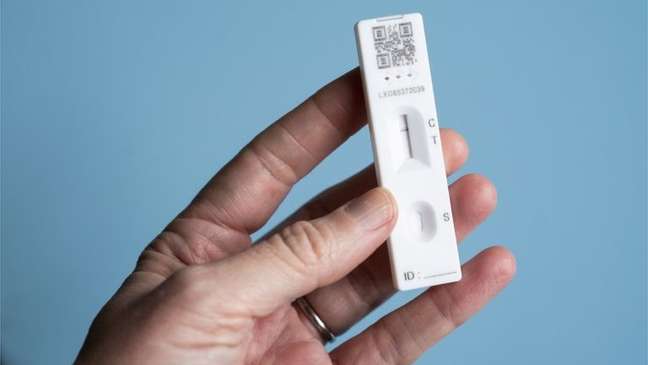
After a significant jump earlier in the year, the volume of covid-19 cases in the country increased again in June.
According to the bulletin of the Secretariats of the National Council of Health (Conass), there are about 35 thousand new diagnoses of the disease per day, as indicated by the seven-day moving average (a measure that smooths out fluctuations in daily records and shows a pandemic trend line ).
The pace is more than double that of April, when Brazil had about 15,000 new diagnoses a day.
Since the January and February epidemic, the country has adopted a new diagnostic method: antigen self-tests, approved by Anvisa this year and sold in pharmacies since March, which can be performed at home by patients themselves.
In what situations are these tests suitable? How do they compare to other antigen and PCR tests? How to correctly interpret the reading cell? BBC News Brasil heard three experts to answer these and other questions about how the disease is diagnosed.
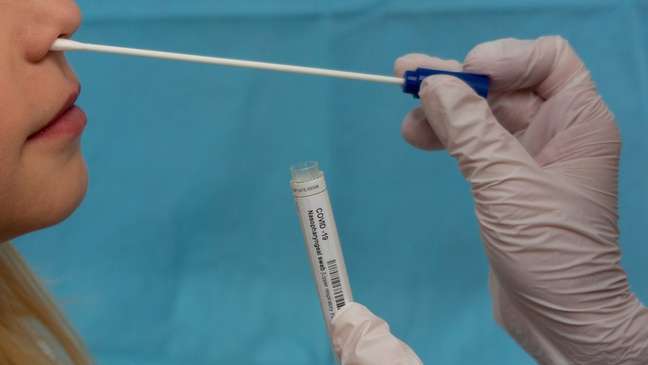
joined by a pad
Both RT-PCR and antigenic tests, including self-tests and tests performed in pharmacies and laboratories, are made from a sample taken from the patient’s nose with a long swab, the swab.
But the similarities end there. RT-PCR, also called molecular test, looks for the virus’ RNA, its genetic material, while antigenic tests detect a protein present in the cellular structure of the virus.
In the case of RT-PCR, the sample is processed in a machine capable of multiplying the genetic material collected over a million times. This increases the sensitivity of the test and, consequently, the likelihood that it will detect the microorganism. There are laboratories that deliver the result in up to four hours – during the outbreak at the start of the year, however, due to the great demand, this deadline was extended to a few days.
With antigen tests, the sample is placed on a piece of paper impregnated with a product that reacts in the presence of a viral protein: part of the slide (the “strip”) changes color within minutes if the protein is detected.
Experts heard by BBC News Brazil reiterate that RT-PCR remains the “gold standard” of diagnosis.
“For those who can do it, this is ideal,” says Celso Granato, an infectious disease specialist with the Fleury group. “But we know that there is a long distance between the ideal and the feasible,” he adds.
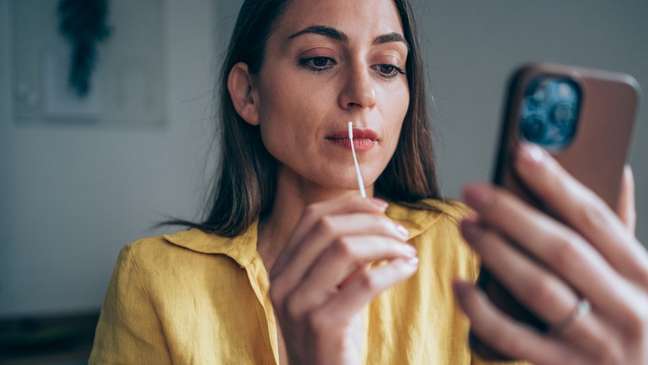
Antigen: self-test, in the pharmacy or in the laboratory?
Many people have opted for antigen tests because they are cheaper and have a faster result.
For pulmonologist Gustavo Prado, of the Alemão Oswaldo Cruz hospital, at the current time of the pandemic, when the country has extensive vaccination coverage – which ensures that most people who contract Sar-CoV-2 will not have severe forms of the disease. “Within bounds” antigen tests are a useful tool for detecting mild cases.
Anyone with severe respiratory syndrome, he points out, whether he suspects covid or not, should go to the health service.
Those who do not have serious symptoms – such as shortness of breath, disorientation and mental confusion, permanent and annoying cough, persistent fever -, he evaluates, may request antigen tests.
“The big question is to understand that not all tests are the same and have different diagnostic performance,” he adds. “And it is necessary to go back to the moment of collection, not only to the reagent itself, to how sensitive and specific it is. These pre-analytical conditions are fundamental for the result to be credible”.
In this sense, for antigen tests to have a better chance of success, says the pulmonologist, they must be performed at the right time (read more below), with an appropriate reagent collection and mixing technique, adequate application in the reading cell and with the necessary processing times.
Also the director of the clinical analysis committee of the Brazilian Association of Diagnostic Medicine (Abramed), Alex Galoro, reiterates the importance of quality in the execution of the different phases of the test, especially in the choice between the self-test, the antigen test carried out in pharmacy and the antigen test carried out in the laboratory.
“The laboratory professional is trained, lives in it, the pharmacist may have received training, but certainly less, so there may be some failure in the execution. In the case of the self-test, even more”, he adds.
Self-test kits for antigen detection, among other things, are different from those used in pharmacies and laboratories, despite using the same mechanism.
For safety reasons, the collection of the material in the self-test is not carried out in the deepest region of the nose, but only in the most superficial area – usually the instructions indicate the insertion of the swab between two and three centimeters in the nose.
In practice, this means that the probability that the sample collected in the self-test has a small viral load – which is not even detected by the reagent – is greater than in the test carried out in a pharmacy or laboratory.
“There can be a lot of false negatives,” Galoro points out.
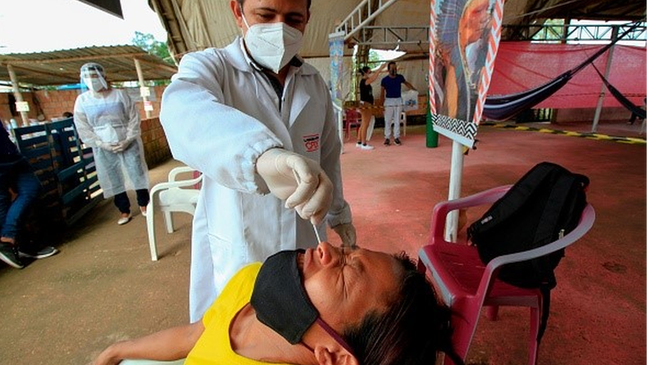
When to do?
In the case of antigen tests, the recommendation is to perform them on the second or third day of symptoms, when there is a greater viral load in the respiratory system of the infected individual and, therefore, the probability of it being detected is greater. Officially, Anvisa suggests doing them between the first and seventh day of symptoms.
For asymptomatic people, it is ideal to do this between three and five days after contact with someone diagnosed with the disease, due to the virus incubation time – which has significantly decreased since the start of the pandemic, especially after the appearance of the omnitron variant. , responsible for the most recent case outbreaks around the world.
“At the beginning the incubation time could range from two to 14 days, this is no longer true. We are seeing many people who have had contact with an infected person and three days later they are already positive”, underlines Granato, of the Fleury group.
How to read the self-test
For those who opt for the self-test, it is important to know how to read the result.
The test slide has two fields: C for “control” and T for “test”. When the result is negative, the colored line appears only in area C. When it is positive, both areas are “painted” on the slide.
Anvisa points out that the result is considered positive regardless of the intensity of the color of the lines.
The test is considered invalid if only the T line is colored, but not the control line; if neither is painted or if there is a large stain on the blade, as shown in the following illustration:
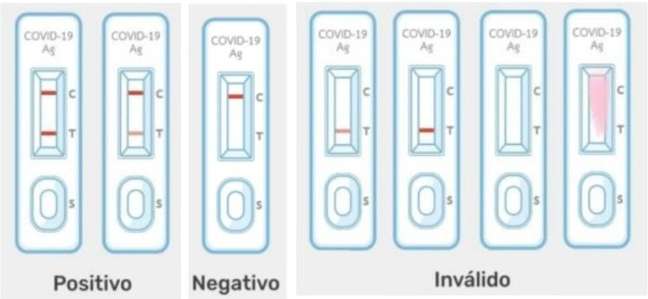
It was positive, now what?
Pulmonologist Gustavo Prado points out that antigen tests are very specific and, therefore, have a low incidence of false positives.
“The positive test came back positive.”
The recommendation is isolation for a period of 7 to 10 days, starting with the first day of symptoms.
Anvisa has even issued a suggestion freeing the end of isolation from the fifth day, with a new test that leads to negative results, but the pulmonologist does not consider the measure safe.
“Something between 10% and 20% of patients could still pass the virus on day five. Ideally, the person completes at least seven days of isolation.”
Was it negative, don’t I have the covid?
The negative results, meanwhile, need to be looked at more carefully, experts say.
The sensitivity of self-tests varies, but many reach around 80 percent, Prado says, meaning that out of 100 positive cases, the test will detect 80.
“The negative test can be false negative,” he muses. Depending on the patient’s condition, if it is a highly suspected case of covid, the healthcare professional may ask you to repeat the test or perform a more sensitive test, such as RT-PCR.
For those who have taken the test because they are asymptomatic and have had contact with someone who has had a positive diagnosis, the doctor’s recommendation is to maintain treatment to avoid transmission – use of a mask, hand hygiene, social distance, preference for open environments and ventilated.
At the start of the pandemic, the orientation was for those who had contact with someone infected to isolate themselves as well, a recommendation that has changed as the disease evolved and vaccination expanded.
Wave of underestimation
The three experts interviewed by the report highlighted that the spread of antigen tests, in particular self-tests, has generated a significant increase in the underreporting of new cases of covid-19, especially mild cases.
“What worries me about the self-test is that not everyone warns the health authorities when the result is positive,” says the infectious specialist Celso Granato. “Here at Fleury we see a positive test result of 50%, a very high percentage, which indicates that the disease is widespread among the population,” he adds.
“This peak [de casos] it’s underpowered, “agrees Galoro.
Anvisa does not consider self-tests as a diagnostic for covid-19. The recommendation is that, once the test is positive, the patient seeks a confirmatory diagnosis in a health service. In real life, however, many of the people who test positive for self-tests, especially in mild cases of the disease, remain in home isolation.
According to Prado, the need for “confirmation” of the result by the health system is “a redundancy that weighs on the system” and can saturate it. At the same time, he adds, the positive test that is not counted «is a diagnosis that does not necessarily generate knowledge [em relação à situação da pandemia no país] or change of program “.
‘This text was originally published in https://www.bbc.com/portuguese/geral-61913887‘
Source: Terra
Benjamin Smith is a fashion journalist and author at Gossipify, known for his coverage of the latest fashion trends and industry insights. He writes about clothing, shoes, accessories, and runway shows, providing in-depth analysis and unique perspectives. He’s respected for his ability to spot emerging designers and trends, and for providing practical fashion advice to readers.






![A more beautiful life in advance [SPOILERS] A more beautiful life in advance [SPOILERS]](https://fr.web.img2.acsta.net/img/90/2d/902d777a1341c7bc0507675575d75b53.jpg)
